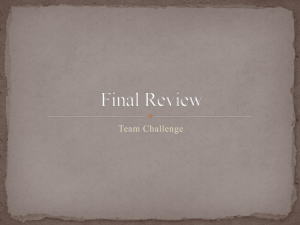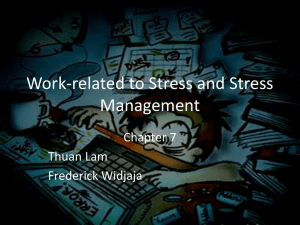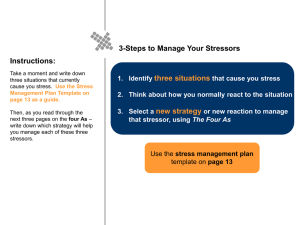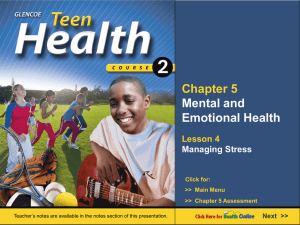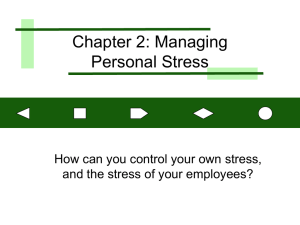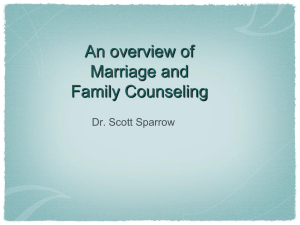Stress - Ch 10
advertisement
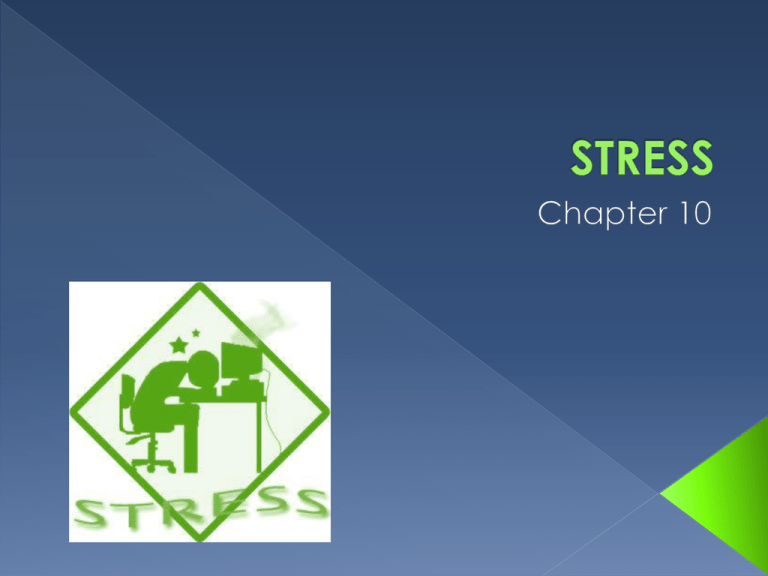
Which of the following events can cause stress? › › › › Taking out a loan Failing a test Graduating from college Watching a hockey game ALL FOUR. Stress-producing factors can be pleasant or unpleasant and can include physical challenges and goal achievement as well as events that are perceived as negative. Moderate exercise can stimulate which of the following: › Analgesia (pain relief) › Birth of new brain cells › Relaxation ALL THREE. Regular exercise is linked to improvement in many dimensions of wellness Which of the following can be a result of chronic stress? › Violence › Heart attack › Stroke ALL THREE. Chronic stress can last for years. People who suffer from long-term stress may ultimately become violent toward themselves or others. They also run a greater than normal risk for certain ailments, especially cardiovascular disease. Stress refers to two different things: › Situations that trigger physical and emotional reactions stressor A first date A final exam › The reaction itself stress response Sweaty palms Pounding heart Stress describes the general physical and emotional state that accompanies a stress response. Systems in our body responsible for physical response to stressors: › Nervous system brain, spinal cord, nerves. › Endocrine system glands, tissues and cells Somatic nervous system: under conscious supervision › Moving your arm away from a flame Autonomic nervous system: not under conscious supervision › Heart rate, breathing, blood pressure Parasympathetic division › In control when you are relaxed › Aids in digestion, storing energy, promoting growth. Sympathetic division › Activated during times of arousal, including exercise and when there is an emergency. › Sympathetic nerves use the neurotransmitter norepinephrine to exert their actions on emergency related organs. During stress, the sympathetic nervous system triggers the endocrine system. Functions by releasing hormones and other chemical messengers into the bloodstream to influence metabolism and other body processes. Is specific, acting on target organs Chemical messages and actions of sympathetic nerves cause the release of key hormones that trigger physiological changes: › Heart and respiration rates increase › Hearing and vision become more acute › The liver releases extra sugar into the bloodstream › Perspiration increases to cool the skin › The brain releases endorphins – chemicals that inhibit or block sensations of pain Once the stressful situation ends, the parasympathetic division of the autonomous nervous system takes command and restores homeostasis. The parasympathetic nervous system calms your body down, slowing a rapid heartbeat, drying sweaty palms and returning breathing to normal. Is a survival mechanism Becomes inappropriate in some circumstances: › › › › Exams Speeches Stop lights or traphic When someone bothers you. The physical response to stressors may vary in intensity from person to person. Several factors help to explain these differences, all related to your cognitive (mental ) appraisal of a potential stressor. This appraisal is: › › Highly individual Strongly related to emotions The facts of a situation typically are evaluated consistently from person to person, but the personal outcome varies Effective and ineffective responses › Common emotional responses to stressors include anxiety, depression and fear › Behavioral responses to stressors are entirely under our control. (Somatic Nervous System) Effective responses Ineffective responses Talking Laughing Exercising Meditating Learning timemanagement skills Overeating Hostility Using tobacco, alcohol or other drugs. Personality and Stress › Personality is the sum of cognitive behavioral and emotional tendencies › Clearly affects how people perceive and react to stressors. › Personality types: Type A Ultracompetitive, controlling, impatient, aggressive and even hostile Reacts explosively to stressors and are upset by events that others would consider only annoyances Type B Relaxed and contemplative Less frustrated by daily events and more tolerant of the behavior of others. Type C Characterized by anger suppression, difficulty expressing emotions, feelings of hopelessness and despair and an exaggerated response to minor stressors. Gender and Stress › Behavioral responses to stressors, such as crying or openly expressing anger may be deemed more appropriate for one gender than other. › Strict adherence to gender roles can limit one’s response to stress and can itself become a source of stress. Past Experiences › Can profoundly influence the evaluation of a potential stressor. Physical, emotional and behavioral responses to stress are intimately interrelated Symptoms of Excess Stress Physical symptoms Emotional Symptoms Behavioral Symptoms •Dry mouth •Excessive perspiration •Frequent illnesses •Gastrointestinal problems •Grinding of teeth •Headaches •High blood pressure •Pounding heart •Stiff neck or aching lower back •Anxiety or edginess •Depression •Fatigue •Hyper vigilance •Impulsiveness •Inability to concentrate •Irritability •Trouble remembering things. •Crying •Disrupted eating habits •Disrupted sleeping habits •Harsh treatment of others •Problems communicating •Sexual problems •Social isolation •Increased use of tobacco, alcohol or other drugs. Stress can increase vulnerability to many affections Several theories have been proposed to explain the relationship between stress and disease › The general adaptation syndrome › Allostatic load › Psychoneuroimmunology Hans Selye (1930 – 1940) Described an universal and predictablee response pattern to all stressors Recognized that stressors can be either pleasant (eustress) or unpleasant (distress). The sequence of physical responses occurs in three stages: Fight- or-flight reaction Distorted perceptions Disorganized thinking Long term overexposure to stress hormones such as cortisol has been linked with health problems. The long – term wear and tear of the stress response is called allostatic load. Depends on many factors including genetics, life experiences, and emotional and behavioral responses to stressors When your allostatic load exceeds your ability to cope, you are more likely to get sick. The study of the interactions among the nervous system, the endocrine system and the immune system Stress, through the actions of the nervous and endocrine systems, impairs the immune system and thereby affects health. › Hormones and chemical messengers released during stress response influence the immune system by affecting the number and efficiency of immune system cells or lymphocytes › Neuropeptides, the biochemical language between brain and the immune system (also language of emotions) can strongly influence the functioning of the immune system. CVD › During stress response, blood pressure rises › Emotional responses increase a person’s risk of CVD Altered functioning of the immune system › Changes in the immune system function include vulnerability to colds and other infections, asthma, allergy attacks, susceptibility to cancer and flare – ups chronic diseases (HIV, herpes). Other health problems Digestive problems Tension headaches and migraines Insomnia and fatigue Injuries Menstrual irregularities, impotence and pregnancy complications › Psychological problems: depression, anxiety, panic attacks, eating disorders, post traumatic stress disorder. › › › › › Major life changes › New jobs, graduation, marriage, moving out. Daily hassles › Losing your keys or wallet College stressors › Academic stress › Interpersonal stress › Time pressures › Financial concerns › Worries abut the future Job-related stressors › Tight schedules and overtime › Worries about performance, salary, job security and interactions with bosses, coworkers and customers. › Helping professions Interpersonal and social stressors › Community and society › Prejudice and discrimination › Language Other stressors › Environmental stressors: loud noises, unpleasant smells, industrial accidents, violence and natural disasters. › Internal stressors: personal goals, evaluate our progress and performance, physical and emotional states such as illness and exhaustion. The best way to manage stress is by pursuing a wellness lifestyle: › Being physically active and doing exercise People who exercise react with milder physical stress responses before, during and after exposure to stressors › Eating well Healthy, balanced diet helps to cope with stress › Getting enough sleep Lack of sleep can be both a cause and an effect of excess stress › Finding social support Sharing fears, frustrations and joys makes life richer and seems to contribute to the well being of body and mind. › Communicating in an assertive way Respect the rights of others as well as your own rights to prevent potentially stressful situations from getting out of control › Striving for spiritual wellness Spiritual wellness is associated with greater coping skills and higher levels of overall wellness. Learning to manage your time Set priorities Schedule tasks Set realistic goals Budget enough time Break up long term goals into short term ones Visualize the achievement of your goals Keep track of the tasks you put off. Consider doing your least favorite tasks first. Consolidate tasks when possible Identify quick transitional tasks Delegate responsibility Say no when necessary Give yourself a break Avoid your personal “time sinks” Stop thinking or talking about what you’re going to do and just do it Changing destructive thinking › › › › › Reduce hostile, critical, suspicious and self-deprecating thoughts Modify your expectations Live in the present Go with the flow Cultivate your sense of humor Writing a diary › Helpful for those who are shy or introverted and find it difficult to open up to others. Relaxation techniques › Progressive relaxation › Visualization › Listening to music › Deep breathing › Meditation › Taijiquan Other techniques › Biofeedback: Measure of stress (heart rate, skin temperature or muscle tensions) mechanically monitored. Feedback is given using sound. › Hypnosis and self-hypnosis: An attentive perception and concentration, which leads to controlled imagination. Lets participants choose to feel something other than anxiety or stress or pain. › Massage: Reduces the stress response, depression and even increases alertness. Peer counseling › Student health center or counseling centers Professional help › Psychotherapy Find out if it’s stress or something more serious such as depression, anxiety or other emotional problems. › Symptoms for depression include Negative self concept Prevasive feelings of sadness and hopelessness Loss of peasure in usual activities Poor appetite and weight loss Insomnia or disrturbed sleep Restlessness or fatigue Thoughts of worthlessness and guilt Throuble concentrating or making decisions Throughts of death or suicide. LAB 10,1 LAB 10.2 Identify your stress level an key stressors Stress-management techniques LAB 10,3 Developing spiritual wellness




